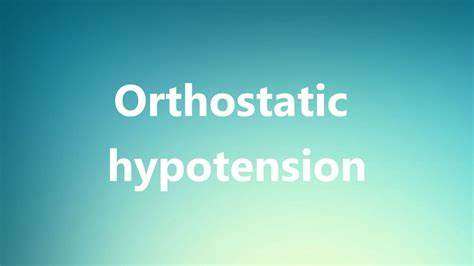Orthostatic hypotension (OH), also known as postural hypotension, is a form of low blood pressure that happens when you stand up from sitting or lying down. It can make you feel dizzy or lightheaded and might even cause you to faint. This condition can be quite challenging to manage, but several effective treatment strategies can help mitigate its symptoms and improve quality of life. This article explores the six best ways to treat orthostatic hypotension, providing detailed insights into each approach.
Causes of Orthostatic Hypotension
Dehydration: Not having enough fluids in your body can lead to a drop in blood pressure.
Heart problems: Conditions such as bradycardia (slow heart rate), heart valve problems, and heart failure can cause OH.
Endocrine problems: Disorders such as adrenal insufficiency (Addison’s disease) or diabetes can affect blood pressure regulation.
Nervous system disorders: Conditions such as Parkinson’s disease and multiple system atrophy can impair the body’s ability to regulate blood pressure.
Medications: Certain medications, including diuretics, beta-blockers, and antidepressants, can contribute to OH.
see also: What Is Reversal of Orthostatic Hypotension?
The 6 Best Ways to Treat Orthostatic Hypotension
1. Increase Fluid and Salt Intake
Increasing fluid intake is one of the simplest and most effective ways to manage OH. Dehydration reduces blood volume, exacerbating symptoms of OH. Drinking more water helps increase blood volume and prevent blood pressure from dropping.
Salt intake is equally important. Sodium helps retain water in the body, thereby increasing blood volume. However, it is essential to consult with a healthcare provider before making significant changes to your salt intake, especially if you have conditions like heart failure or kidney disease.
Practical Tips:
Aim for at least 8 glasses of water per day.
Add a moderate amount of salt to your diet through salty foods or electrolyte drinks.
Monitor your fluid and salt intake and adjust as needed based on symptoms and medical advice.
2. Wear Compression Stockings
Compression stockings are designed to apply pressure to your legs, helping to reduce the pooling of blood in the lower extremities. This can help maintain blood pressure when you stand up.
Types of Compression Garments:
Knee-high stockings: These are the most commonly used and can be very effective.
Thigh-high stockings: These provide more comprehensive support but can be less comfortable.
Abdominal binders: These can be used in conjunction with stockings to provide additional support.
Practical Tips:
Wear compression stockings during the day, especially when you need to stand or walk for extended periods.
Choose the appropriate compression level based on your symptoms and comfort.
Consult with a healthcare provider to find the right type and size of compression stockings for you.
see also: 6 Main Causes of Spinal Hypotension
3. Physical Counter-maneuvers
Physical counter-maneuvers involve simple movements and postures that can help prevent or reduce symptoms of OH.
These maneuvers help increase blood flow back to the heart, thereby improving blood pressure.
Effective Maneuvers:
Leg crossing and tensing: Cross your legs tightly while standing and tense your leg muscles.
Squatting: Squatting down can quickly raise blood pressure.
Bending forward: Bend at the waist to help blood return to your heart.
Sitting down: If you feel lightheaded, sit down immediately to prevent fainting.
Practical Tips:
Practice these maneuvers regularly to become proficient.
Use these techniques as soon as you feel symptoms of OH coming on.
Combine maneuvers with other treatment strategies for better results.
4. Medications
Several medications can help manage OH, especially when lifestyle modifications are not sufficient. These medications work by increasing blood volume, tightening blood vessels, or improving the body’s ability to regulate blood pressure.
Common Medications:
Fludrocortisone: A corticosteroid that helps increase blood volume by retaining sodium.
Midodrine: An alpha-agonist that tightens blood vessels and raises blood pressure.
Pyridostigmine: An acetylcholinesterase inhibitor that improves the body’s ability to regulate blood pressure.
Practical Tips:
Always take medications as prescribed by your healthcare provider.
Report any side effects or changes in symptoms to your doctor.
Regularly monitor your blood pressure to ensure the medication is effective.
5. Lifestyle Modifications
Lifestyle modifications can significantly impact the management of OH.
These changes can help reduce symptoms and improve overall health.
Effective Modifications:
Slow positional changes: Avoid standing up quickly. Rise slowly from sitting or lying down positions.
Elevate the head of your bed: Sleeping with the head of your bed elevated can help reduce nighttime and morning symptoms.
Eat small, frequent meals: Large meals can divert blood flow to the digestive system, exacerbating OH. Small, frequent meals help maintain blood pressure.
Avoid alcohol: Alcohol can lower blood pressure and worsen OH symptoms.
6. Regular Exercise
Regular exercise can improve cardiovascular health and help manage OH. Exercise helps strengthen the heart and improve blood circulation, which can reduce symptoms.
Recommended Exercises:
Aerobic exercises: Walking, swimming, and cycling are excellent for improving cardiovascular health.
Strength training: Strengthening leg and core muscles can help reduce blood pooling in the lower extremities.
Balance exercises: Yoga and tai chi can improve balance and reduce the risk of falls.
Conclusion
Orthostatic hypotension can be a challenging condition, but with the right strategies, its symptoms can be effectively managed. Increasing fluid and salt intake, wearing compression stockings, performing physical counter-maneuvers, taking medications, making lifestyle modifications, and engaging in regular exercise are six of the best ways to treat OH. Each individual’s experience with OH is unique, so it’s essential to work closely with a healthcare provider to develop a personalized treatment plan. By implementing these strategies, individuals with OH can improve their quality of life and reduce the impact of this condition on their daily activities.

